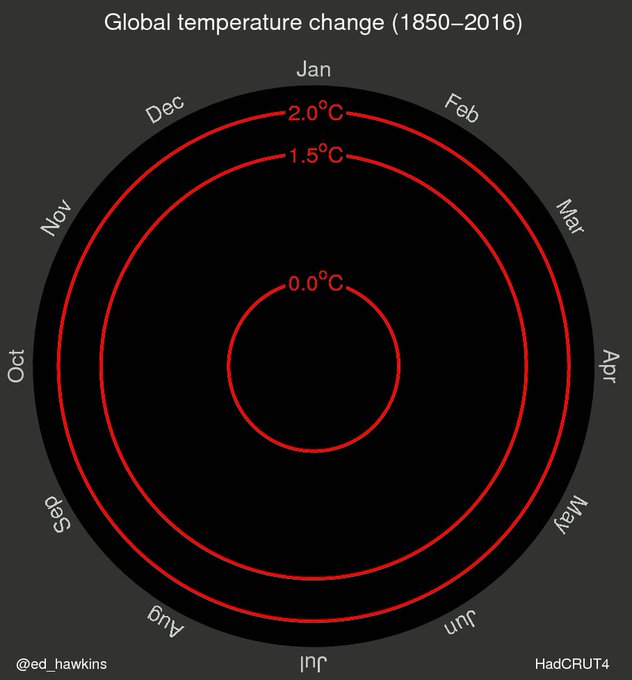| Above: West Palm Beach broadcast meteorologist Jeff Berardelli (CBS12) with the warming-stripes graphic being used in Thursday’s Meteorologists United on Climate Change campaign. Image credit: Courtesy Jeff Berardelli. |
Close to 100 broadcast meteorologists will don blue and red stripes for their on-air segments Thursday as part of an international effort to raise awareness of the reality of human-produced climate change. The campaign, Meteorologists United on Climate Change, is scheduled for June 21, the Northern Hemisphere’s summer solstice, when sizzling temperatures and the risks of extreme heat are already on people’s minds. The project’s Twitter hashtag is #MetsUnite.
The visual centerpiece of the campaign is the instantly iconic “warming stripes” graphic. It was created by climate scientist Ed Hawkins, a professor at the University of Reading and a principal researcher at the U.K.’s National Centre for Atmospheric Science. Perhaps his best-known graphic is the “warming spiral” animation (see embedded tweet below), which has been viewed millions of times since its debut in 2016.
The warming-stripes graphic includes one colored stripe for each year of global temperature from 1850 to 2017, as calculated by the UK Met Office Hadley Centre, with the colors changing from blue to red as temperatures rise. Another version of the graphic includes each year of temperature data from 1772 to 2017 from the Central England Temperature dataset, the longest instrumental temperature record on Earth.
“I wanted to communicate temperature changes in a way that was simple and intuitive, removing all the distractions of standard climate graphics so that the long-term trends and variations in temperature are crystal clear,” said Hawkins in an email. “Our visual system will do the interpretation of the stripes without us even thinking about it.”
Bringing climate change home to the public
Meteorologists United on Climate Change is the brainchild of Jeff Berardelli, a weathercaster at CBS12 (WPEC) in West Palm Beach, Florida. To help his colleagues spread the word graphically, Berardelli arranged for a variety of items, from ties and pins to coffee mugs and mouse pads, to be made available through the online marketer Zazzle.com.
“Traditionally [broadcasts] meteorologists have shied away from climate change communication,” said Berardelli in an email. “Some don’t want to turn away unreceptive viewers, while others may feel that they don’t have a firm enough grasp on all the particulars. But the time has come for meteorologists to step up to the plate. This is our day job, and our reach as a group is vast. If we do not take the helm, who will do it?”
The project is cosponsored by Climate Central, the Princeton-based nonprofit that carries out a wide variety of communications and research activities on climate change and its impacts. Bernadette Woods Placky manages CC’s Climate Matters program, which was launched in 2010 as a pilot project to engage weathercasters in addressing climate-related topics. About 520 meteorologists are now entrained in Climate Matters, which develops seasonally and regionally relevant material in both English and Spanish. The program’s extensive online resources include an Extreme Heat Toolkit, with a wealth of graphics showing intensified summer heat in a variety of modes.
 |
| Figure 2. A new Climate Central analysis of NOAA/NCEI data on summer temperatures at 244 U.S. cities, averaged from June through August, found that 92% of the cities were seeing more warmer-than-average summer days than they experienced a half-century ago. Some of the largest increases are in Florida, Louisiana, and Texas, whose summers are already famously hot and humid. The study compared readings from 1970 to 2017 to the NOAA/NCEI averages for the period 1981-2010. For each month, the study tallied the number of days when the daily average temperature departure from normal (including both daily highs and lows) was greater than zero. As shown above, Houston now sees more than 50 summer days warmer than the 1981-2010 average, as opposed to less than 20 days in that same temperature range in the early 1970s. Image credit: Climate Central. |
Berardelli hatched the idea for the awareness campaign in online discussions with other participants in Climate Matters. “That’s when I jumped on and said, ‘That’s fantastic—what can we do to support this?’” said Placky. The summer-solstice timing is no accident, she added: “This is our season of extreme heat. We really want our local communities to know what’s going on. There’s so much confusion about climate change. These are TV mets delivering the science to really inform our communities.”
A 2017 study in the Bulletin of the American Meteorological Society led by Edward Maibach (George Mason University) shows that roughly 80% of weathercasters are now convinced of human-caused climate change, and a majority believe that climate change has already affected conditions in their local markets. “Weather Geeks” podcast host Marshall Shepherd (University of Georgia) noted the changing landscape in a Forbes post on Tuesday: “The Summer Solstice is a transition period for the planet and perhaps #MetsUnite will usher in one as well.”
Berardelli added: “The message is simple: humans have become a force of nature. Our influence on the climate matches or exceeds the impact of natural variations. It’s real. It’s us. It’s serious. And while the public opinion ship has veered in a favorable direction, we need an abrupt pivot, right now, to avoid the worst impacts of the iceberg called climate change.”


